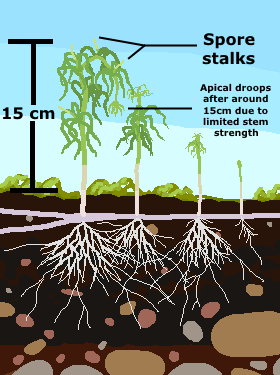39 Wireshoot
Name: Wireshoot
Descendant of: Crawire
Description: Wireshoot keeps it's roots underground to avoid sun exposure. It may get a lot of rain but when the sun is out at the equator it can still be very hot, capable of causing mild burns to living tissue and with a lot of evaporation occuring, so the soil helps protect them as they are the most important living part of the plant.
The roots have differentiated into two types. One is a rhizome-like root which grows horizontally beneath the soil surface and expands the root network. This type of root transports water and nutrients but doesn't extract much of it from the soil. It does however store complex carbohydrates for leaner times. From this type of root, foliage shoots grow upwards while a smaller type of root (known here as the "bundle root" type of root) grows in bunches that branch outwards from a point of origin on the rhizome-like root. This second type of root is for water and nutrient extraction from the soil. They rely on nutrients being freed by soil biota such as animals, fungi and bacteria.
The foliage breaks the soil surface as many small green shoots that spring up wherever the roots have expanded to, so tend to grow in close proximity to one another like a carpet. To break the soil surface the shoots have to be a bit strong, which has the secondary benefit of allowing the foliage to grow taller before bending over. The wiry strands of foliage are filled with a spongy photosynthetic tissue and have a tube-like skin surrounding each strand. The stalk is similar internally but has a few additional subdivisions of cell type that help transport water and nutrients between the foliage and the roots. Each strand of foliage is less firm towards the tapering end of the strand, so it initially grows upwards before dangling over past a certain length. The main stalk shows a similar behaviour, with the apical head hanging over when it gets too tall.
Reproduction: It reproduces by growth and fragmentation of it's rhizome-like roots (clones) but also regularly produces tiny air borne asexual spores.
Food: Photosynthesis
Ocean Locations: None
Land Locations: 9 (Freshwater), 10, 11 (Both: Freshwater and dry land)
Remove these ads. Join the Worldbuilders Guild










Comments